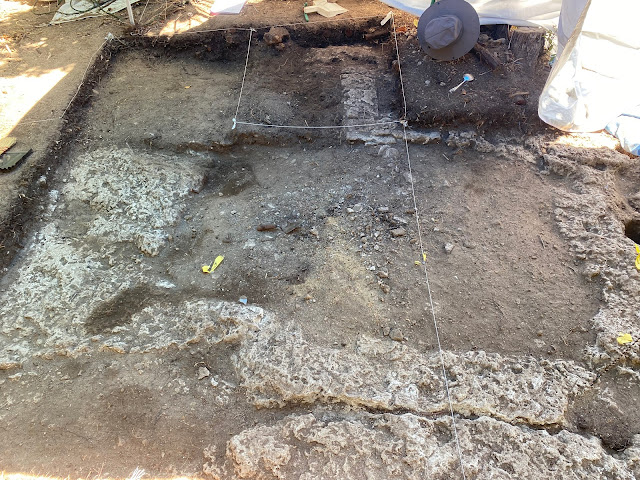The Megafeature of Locus A
As most of the crew scrambled to excavate all the post holes and natural features in Locus B to the south, Megan, Ewan, and a few guest excavators chased the edges of a surprisingly large pit feature that emerged a dozen feet or so east of the stone ruin's eastern wall.
Had it not been for the Ground Penetrating Radar indicating a large deep feature was in this area we would not have dug here - largely because these units were covered by a very large fiddlewood tree and a cluster of old Mexican Pepper trees. In retrospect, the larger than average size of these trees likely resulted from having much deeper soil to draw upon than its neighbors (leading me now to closely scrutinize other big trees in the area!) but they were a bear to get rid of - more than my little chainsaw could handle.In the end, a large loaner chainsaw (thanks, Andre!) and Megan and Sarah's grit defeated the Fiddlewood (which they named Stan) cleared the way for further excavation.
With access cleared, we followed the edge of the large feature east and south, opening eight meter-square units to fully expose its dimensions. Along the way we also found what appears to be a grave cut and also the corner of a cut-stone wall, whose purpose is unclear.
 |
| The Water Cistern at Oven Site, 2017 |
The dimensions are very close to that of the tarris-lined water cistern discovered at Oven Site in 2015 and partially excavated in 2017, and it would make sense to have a water catchment at a quarantine site close enough to a roofed building to channel rainwater to it.
Excavation within the feature commenced on the last day of the dig, mainly to form a preliminary idea about its dating and function. The top layer of feature fill had a high concentration of mid- to late-18th-century material including creamware and hand-painted pearlware but not transfer-printed pearlware, suggesting it was filled in in the last quarter of the 18th century. The presence of a thick scatter of mortar fragments also suggests that the filling of this feature coincided with the destruction of a structure nearby, perhaps one surrounding it.
This interpretation raises the possibility that the present standing stone ruin may have been built by the military in the 1790s to replace an earlier civilian Bermudian quarantine structure associated with this pit, rather than that the stone ruin served as both the 18th -century smallpox quarantine and 19th-century yellow fever retreat sites. The most puzzling artifact to emerge was a solid shank French naval officer's button, likely dating to the early 19th-century, found at the top interface of the feature fill and the stone ruin's yard scatter.
In the last few hours of the 2022 season, excavation of the pit's western edge revealed that in fact the feature did NOT have a plastered interior surface (as a cistern would have) and the initial covering of small mortar fragments gave way to larger broken cut stones positioned with irregular orientations that suggest they were thrown into the pit during a rapid fill episode. Most puzzling of all was the emergence of a small hard stone basin positioned upright, which had been carefully cut out of native bedrock (as revealed by tool marks on its sides and base).

The odd ecofact was fully exposed and removed, but its function and significance remain a mystery. On student likened it to a font for holding Holy Water and perhaps it did serve as a liquid basin within the quarantine house, but firmer identification remains elusive. Thoughts, anyone? Please leave comments!
As has been so often the case, I am left in suspense as to the age and identity of this feature, as well as about the shape and association of the stone wall corner adjoining it. I will be thinking about it all semester as the University of Rochester starts up again this week. May 2023 cannot come soon enough!













.jpg)
Comments